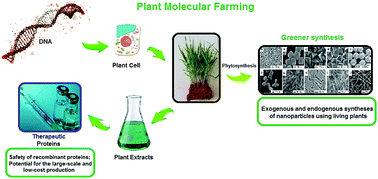Plant molecular farming: production of metallic nanoparticles and therapeutic proteins using green factories
Abstract
Plants have had numerous biological, clinical, pharmaceutical and medicinal purposes for many years; however, their use as a general platform for preparation of desired pharmaceutical and biomedical compounds is relatively current. Secondary metabolites with remarkable and diverse biological functions are produced by medicinal plants. Significant advancements in nanosciences have enabled their various applications in the development of a new generation of drug molecules. Due to the application of toxic solvents and high energy consumption of conventional physical and chemical approaches, greener and eco-friendly methods are essential and vital. Plants can provide an outstanding alternative for the production of phytomaterials and biomaterials, and this review highlights the exogenous and endogenous syntheses of nanoparticles using living plants. Additionally, the plant nano-molecular farming of proteins including collagen, gelatin, elastin, recombinant anti-cancer monoclonal antibodies and recombinant anti-cancer vaccines is discussed.

- This article is part of the themed collection: Celebrating Latin American Talent in Chemistry


 Please wait while we load your content...
Please wait while we load your content...